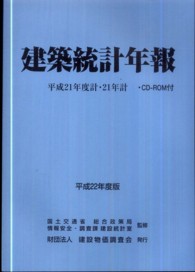- ホーム
- > 洋書
- > 英文書
- > Religion / Ethics
基本説明
Offers several different approaches to Jung's psychology in relation to religion, theology, and contemporary culture.
Full Description
Swiss psychologist Carl Jung (1875-1961) has made a major, though still contested, impact on the field of religious studies. Alternately revered and reviled, the subject of adoring memoirs and scathing exposes, Jung and his ideas have had at least as much influence on religious studies as have the psychoanalytic theories of his mentor, Sigmund Freud. Many of Jung's key psychological terms (archetypes, collective unconscious, individuation, projection, synchronicity, extroversion and introversion) have become standard features of religious studies discourse, and his extensive commentaries on various religious traditions make it clear that Jung's psychology is, at one level, a significant contribution to the study of human religiosity. His characterization of depth psychology as a fundamentally religious response to the secularizing power of modernity has left a lasting imprint on the relationship between religious studies and the psychological sciences. This book offers a collection of original articles presenting several different approaches to Jung's psychology in relation to religion, theology, and contemporary culture. The contributors describe their teaching of Jung in different academic contexts, with special attention to the pedagogical and theoretical challenges that arise in the classroom.
Contents
Introduction: Teaching With and Against Jung ; Kelly Bulkeley and Clodagh Weldon ; Part I. Different Educational Settings ; Chapter One: The Challenge of Teaching Jung in the University ; David Tacey ; Chapter Two: Misprision: ; Pitfalls in Teaching Jung in a University Religious Studies Department ; David L. Miller ; Chapter Three: Teaching Jung in a Theological Seminary and a Graduate School of Religion ; Ann Belford Ulanov ; Chapter Four: Teaching Jung in an Analytic Psychology Institute ; Murray Stein ; Part II. The Interpretation of Religious Texts and Experiences ; Chapter Five: Jung's Approach to Myth ; Robert Alan Segal ; Chapter Six: Jung's Engagement with Christian Theology ; Charlene Burns ; Chapter Seven: God on the Couch: ; Teaching Jung's Answer to Job ; Clodagh Weldon ; Chapter Eight: Type-wise: ; Using Jung's Theory of Psychological Types in Teaching Religious Studies Undergraduate and Graduate Students ; Christopher Ross ; Part III. Jung's Life, Work, and Critics ; Chapter Nine: Personal Secrets, Ethical Questions ; John Haule ; Chapter Ten: Anima, Gender, Feminism ; Susan Rowland ; Chapter Eleven: Jung as Nature Mystic ; Meredith Sabini ; Chapter Twelve: Teaching Jung in Asia ; Jeremy Taylor ; Part IV. Jungian Practices in the Classroom and Beyond ; Chapter Thirteen: Teaching Jung and Dreams ; Kelly Bulkeley ; Chapter Fourteen: Jung and Winnicott in the Classroom: ; Holding, Mirroring, Potential Space and the Self ; Laurel McCabe ; Chapter Fifteen: Jung and the Numinous Classroom ; Bonnelle Strickling ; Chapter Sixteen: Can There Be a Science of the Symbolic? ; John Beebe







